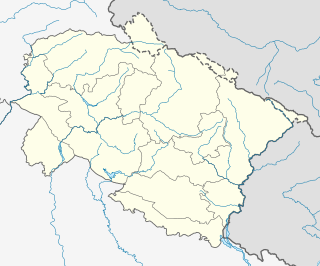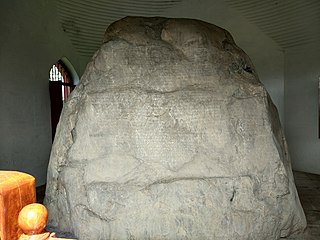See also
- Mehdi Khalsi, Moroccan boxer
- Kalsi
| This disambiguation page lists articles associated with the title Khalsi. If an internal link led you here, you may wish to change the link to point directly to the intended article. |
Khalsi may refer to:
| This disambiguation page lists articles associated with the title Khalsi. If an internal link led you here, you may wish to change the link to point directly to the intended article. |

Leh district is a district in the union territory of Ladakh in northern India. With an area of 45,110 km2, it is the second-largest district in the country in terms of area. It is bounded on the north by Gilgit-Baltistan's Kharmang and Ghanche districts and Xinjiang's Kashgar and Hotan prefectures linked via the historic Karakoram Pass. It has Aksai Chin and Tibet are to the east, Kargil district to the west, and Lahul and Spiti to the south. The district headquarters is in Leh. It lies between 32 to 36 degree north latitude and 75 to 80 degree east longitude.

Daulatpur is an upazila of Manikganj District in the Division of Dhaka, Bangladesh.
Mehdi Khalsi is a Moroccan amateur boxer who competed at the 2008 and 2012 Olympics at welterweight (69 kg).

Khaltse or Khalsi is the headquarter of eponymous Subdivision, block and tehsil in the Leh district of Ladakh, India. It is located 337 km from Srinagar on the old main road to Leh, where it crossed the Indus over an iron bridge. Much of its importance is because it is the place where the road from Kashmir debouches into the Indus Valley. Close by are the remains of an old fortified customs house.

Khalsi is a town in Dehradun District, Uttarakhand. It is known for the Rock edicts of Khalsi, a group of major inscriptions by emperor Ashoka. The Khalsi rock contains the Major Rock Edicts 1 to 14.

Youl Chung is a village in the Leh district of Ladakh, India. It is located in the Khalsi tehsil.

Skinlingyong is a village in the Leh district of Ladakh, India. It is located in the Khalsi tehsil.

Lingshet is the headquarter of Singelalok block in the Leh district of Ladakh, India. It is located in the Khalsi tehsil, about a day's trek from the nearest road.

Lamayouro is a village in the Leh district of Ladakh, India. The Lamayuru Monastery is located nearby. It is located in the Khalsi tehsil.

Leido is a village in the Leh district of Ladakh, India. It is located in the Khalsi tehsil.

Fotoksar is a village in the Leh district of Ladakh, India. It is located in the Khalsi tehsil.

Temisgam is a village in the Leh district of Ladakh, India. It is located in the Khalsi tehsil. The Tingmosgang castle and monastery are located here.

Hanu is a village panchayat in the Leh district of Ladakh, India. It consists of two villages, Yogma Hanu and Goma Hanu, a few miles to the north, in the Hanu valley below the Chorbat La pass. The villages form part of the Khalsi tehsil.

Takmachik is a village in the Leh district of the Indian union territory of Ladakh. It is located in the Khalsi tehsil, around 14 km from the Khaltsi and 112 km west of the district headquarters Leh.

Wanla is a village in the Leh district of Ladakh, India. It is located in the Khalsi tehsil, on the banks of the Yapola River. The Wanla Monastery is located in this village.

Dah is a village in the Leh district of Ladakh, India. It is located in the Khalsi tehsil.

Domkhar is a village in Leh district of Ladakh in India. It is located in the Khalsi tehsil.

Tia is a village in the Leh district of Ladakh, India. It is located in the Khalsi tehsil.

Nurla is a village in the Leh district of Ladakh, India. It is located in the Khalsi tehsil.

The Rock edicts of Khalsi, also Kalsi, are a group of an Indian rock inscriptions written by the Indian Emperor Ashoka around 250 BCE. They contains some of the most important of the Edicts of Ashoka. The inscription in Khalsi contains all the Major Rock Edicts, from 1 to 14. They were discovered in Khalsi, a village in Uttarakhand, northern India, by Alexander Cunningham about 1850.